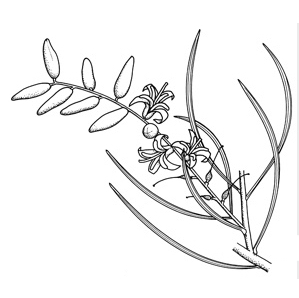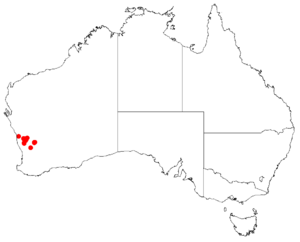Persoonia chapmaniana facts for kids
Quick facts for kids Persoonia chapmaniana |
|
|---|---|
 |
|
| Conservation status | |
| Scientific classification | |
| Genus: |
Persoonia
|
| Species: |
chapmaniana
|
 |
|
| Occurrence data downloaded from AVH | |
Persoonia chapmaniana is a special kind of flowering plant. It belongs to the Proteaceae family, which has many unique plants. This plant is only found in the south-west part of Western Australia. This means it is endemic there, like a plant native only to that area. It grows as an upright, spreading bush. It has smooth bark and long, thin leaves with a sharp tip. Its bright yellow flowers grow in groups of five to thirty. These flowers appear along a stem-like part called a rachis, which can be up to 60 millimeters long.
Contents
What Does Persoonia chapmaniana Look Like?
Persoonia chapmaniana is an upright, spreading bush. It usually grows to be about 1 to 2 meters tall. That's like being as tall as a grown-up or even taller!
It has smooth bark that looks mottled, like it has different shades of grey. Its small branches are quite hairy. The leaves are long and thin, like a line. They are about 20 to 80 millimeters long and less than 2 millimeters wide. Each leaf has a very sharp point at its end.
The bright yellow flowers grow along a stem called a rachis. This stem can be 15 to 60 millimeters long. Each flower sits on a tiny stalk called a pedicel, which is up to 5 millimeters long. The flower parts, called tepals, are yellow and measure between 5.5 and 11.5 millimeters long. They are smooth on the outside.
This plant blooms from September to November. After the flowers, it grows a fruit. This fruit is a bumpy, stone-like fruit called a drupe. It is about 7.5 to 12 millimeters long and 4 to 5 millimeters wide.
How This Plant Got Its Name
The plant Persoonia chapmaniana was officially named in 1994. A scientist named Peter Henry Weston described it in a science journal called Telopea.
The plant was discovered from samples collected by Charles Chapman in 1981. He found them near the road between Carnamah and Eneabba in Western Australia. The second part of the plant's name, chapmaniana, is a way to honor Charles Chapman. He was the person who collected the first samples of this plant.
Where Does This Plant Live?
This special plant, a type of geebung, grows in woodlands. It likes to live near salt lakes. You can find it in areas like Coomberdale, Lake Ninan (near Wongan Hills), and Kulja.
These places are part of different natural areas in Western Australia. These areas are called the Avon Wheatbelt, Geraldton Sandplains, and Swan Coastal Plain.
Is This Plant Protected?
Persoonia chapmaniana is listed as "Priority Three" by the Government of Western Australia's Department of Parks and Wildlife.
What does "Priority Three" mean? It means that scientists don't know a lot about this plant yet. It has only been found in a few places. However, it is not in immediate danger of disappearing. This classification helps protect it while more is learned about it.


